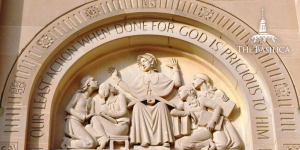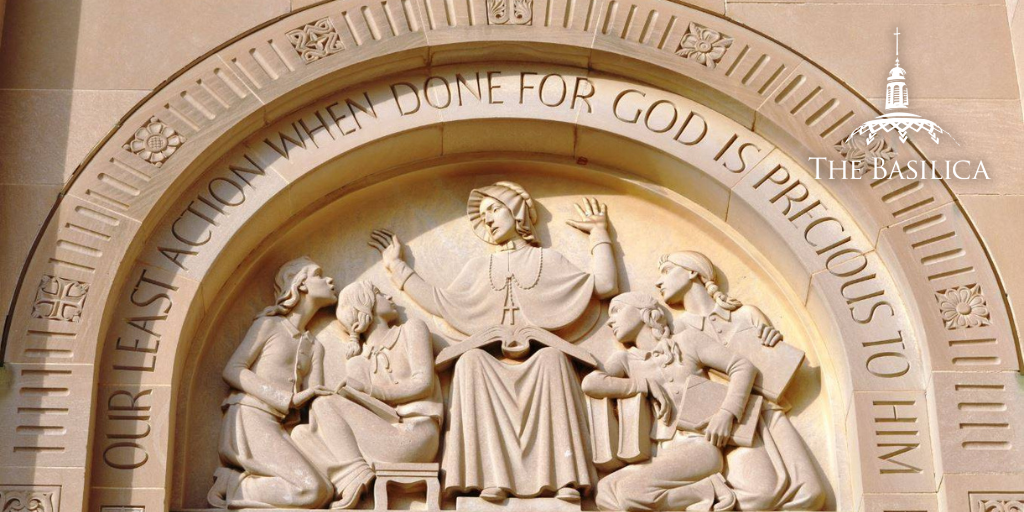
Throughout history, women have played a vital role in spreading the Gospel and fostering the growth of the Church. From St. Catherine of Siena’s spiritual boldness to St. Elizabeth Anne Seton’s dedication to education, their examples of devotion continue to inspire the faithful today. As we celebrate International Women’s Day on March 8, we invite readers to explore the stories of four women saints everyone should know and discover where they are portrayed in the Basilica.
1. Saint Kateri Tekakwitha
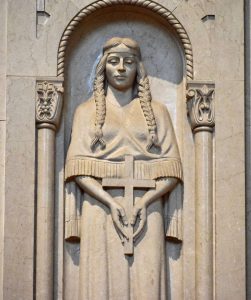
Saint Kateri Tekakwitha was the first indigenous American to be canonized as a saint. Known as the “Lily of the Mohawks,” she is the patroness of ecology and environment. Born to a Mohawk chief in 1656, Kateri was left an orphan at age four after an epidemic of smallpox took both her parents and her brother. She was raised by her uncle in a Mohawk tribe community, and in 1676, Kateri was baptized by Father Jacques de Lamberville, a Jesuit missionary. Kateri became a devoted Christian, and at age 19, she took a vow of chastity. While her exemplary piety served as an inspiration to some of those around her, others harassed her because of her faith.
Seeking a less hostile environment, she moved to the settlement of the Mission of St. Frances Xavier, a community of Christian indigenous Americans living near what is now Montreal. There, she grew in faith and holiness, spurred on by an unquenchable zeal for Christ, living in prayer and penitence. Only five years later, however, she was called home by the Lord, passing away at the young age of 24 on April 17, 1680. Her last words were: “Jesus, I love you.” Saint Kateri is portrayed in the Hall of American Saints, the Trinity Dome, the Our Lady of Guadalupe Chapel, and the southwest nave bay in the Upper Church.
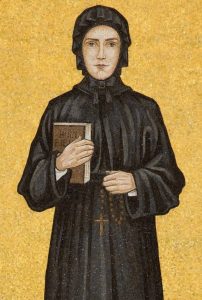
2. Saint Elizabeth Ann Seton
The first native-born American citizen to be canonized as a saint, Elizabeth Ann Seton is best known for her role in starting the parochial education system in America. Born on August 28, 1774, on Staten Island, Elizabeth was originally raised in the tradition of the Episcopal church. After spending time in Italy, she was struck by the beauty of Catholicism and converted in 1805. Following her husband’s premature death, Elizabeth started a Catholic school for girls in Baltimore, Maryland, at the request of a priest. Elizabeth’s most lasting impact, however, was the founding of the Sisters of Charity of Saint Joseph’s in 1809 – the first religious order in America. This order helped hospitals and orphans, but its most prominent work was in establishing the parochial education system in America. Elizabeth’s devotion to educating children and caring for the less fortunate has had an impact lasting well beyond her own life.
Mother Elizabeth Ann Seton is depicted on the exterior tympana of the West Façade, the Hall of American Saints, Miraculous Medal Chapel window, Our Lady of Guadalupe Chapel, and the Trinity Dome Mosaic.
3. Saint Catherine of Siena
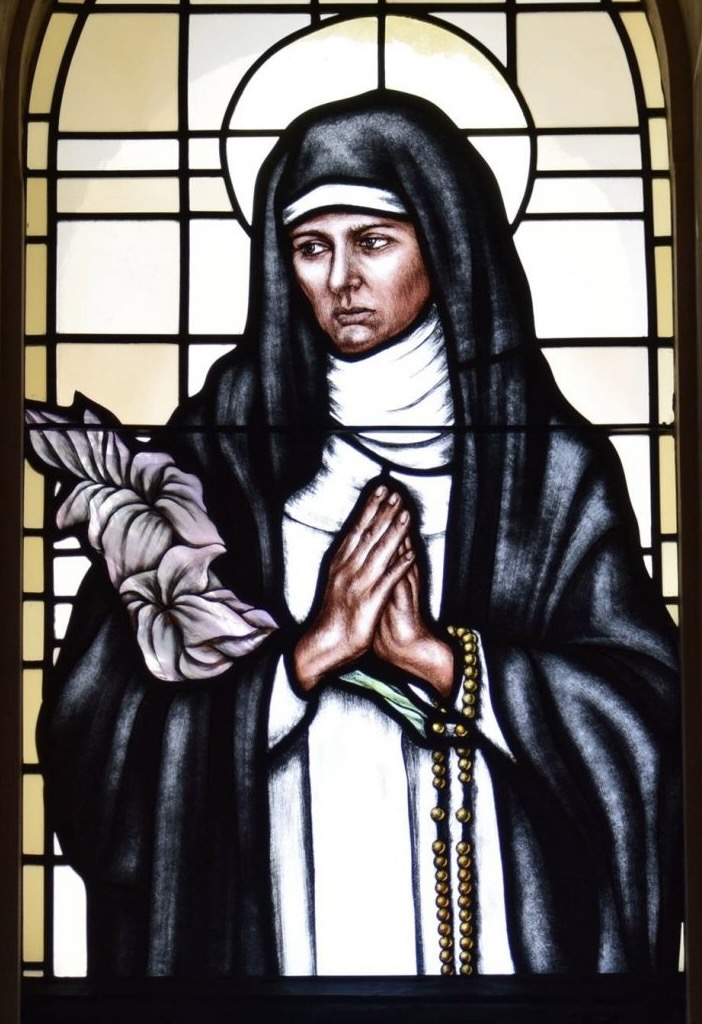
In 1347, Catherine was the 25th child born to an Italian wool-dyer and cloth merchant. When Catherine was just 15, she became a lay Dominican. Instead of entering a convent, Catherine lived a solitary lifestyle for three years, during which time she was inundated with disturbing mystical visions. But one day, they vanished – and she saw Christ in their place. These visions of Christ began to happen every day, and at age 20, she decided to forsake her life of hermitage and dedicated herself to serving others.
Catherine became a champion for truth, writing her most popular books during this time, and sending letters to authority figures in the Church and government. She also became known for her diplomatic cunning, negotiating peace between armies and mediating family feuds. Catherine was bold, unafraid to call out Church leaders for letting money influence appointments and making decisions from personal and political motivations. As she watched the Church around her continue in a pattern of spiritual decay, Catherine believed that she could carry the weight of its atonement. In her last mystical experience, she felt the Church’s weight on her back, and collapsed into a state of excruciating paralysis. Within weeks, at age 33, she died. Saint Catherine was the first woman to be granted the title “Doctor of the Church.”
Saint Catherine is honored in the Basilica in the Saint Catherine of Siena Chapel, as well as in the Our Lady of the Rosary Chapel and the Our Lady of Pompei Chapel.
4. Saint Elizabeth
The wife of a priest, Saint Elizabeth lived during the reign of King Herod. Elizabeth remained barren for most of her life, but God had not forgotten her. The Bible describes her as righteous and upright before God, and she was ashamed that she had not had any children. In fact, when she discovered that she was pregnant, she responded that the Lord “had seen fit to take away my disgrace.” This is a contrast to her husband, who was struck mute when he responded in disbelief to the angel that brought him the news.
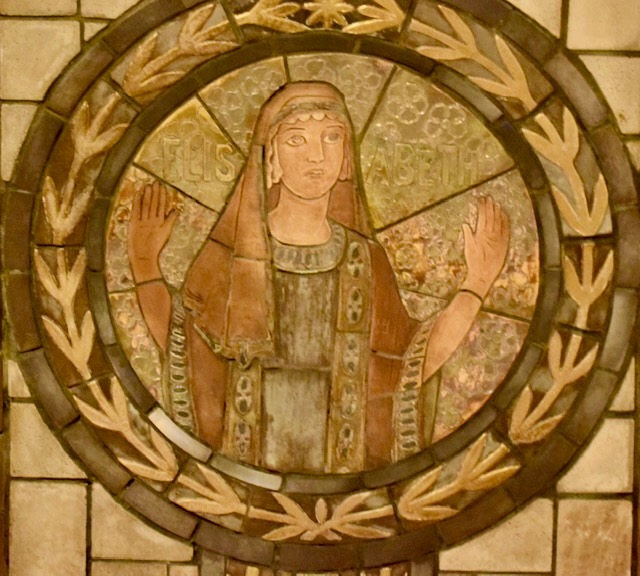
Elizabeth was also related to Mary, whose pregnancy story intersects with her own. It was upon Mary’s visit that Elizabeth called Mary blessed, and Mary responded with what we now know as the Magnificat.
A few months later, Elizabeth gave birth to a son, and when they brought him to be circumcised at eight days old, her neighbors and relatives tried to convince her to name him after his father. Elizabeth responded that he would be called John, even though none of their relatives had the name. They asked Zechariah what they wished for the child to be called, and he wrote on a tablet that the boy’s name was John. Instantly he recovered his ability to speak and praised God. All their neighbors were amazed and said that the child must be destined for great things, because the hand of the Lord was upon him.
Saint Elizabeth is featured in the Basilica in the South Entrance, the St. Elizabeth Chapel, in the Pewabic rondel ceiling in the Northern Apse of the Crypt Church, in the East Chancel Clerestory Window, and in the Rosary Garden.
Sources:
The Basilica Guidebook, Dr. Geraldine Rohling
Beatific Profile of Kateri Tekakwitha, The Vatican
Butler’s Lives of Saints, ed. Bernard Bangley
The Way of Saints, Dr. Tom Cowan

